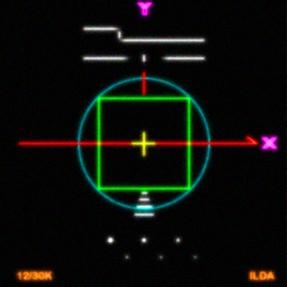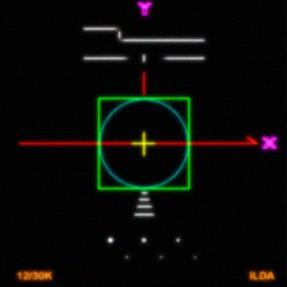 |
SHENZHEN LANLING TECHNOLOGY CO., LTDThe Pro manufactuer of stage laser lights and LED lights in China |
|
||||||
How to tune to the ILDA test pattern
By Bill Benner and Patrick Murphy, Pangolin Laser Software
Note: The information reproduced here was originally published in the Winter 1994 edition of Laser Effects The Light Show Quarterly and is reproduced here by permission.
The ILDA test pattern was adopted on 24 June 1992. At the date of publication in Laser Effects, ILDA has not yet published any instructions for using the test pattern. There are still elements of the test pattern which are undocumented anywhere. To help fill the information gap, Laser Effects prevailed upon Pangolin Laser Software to write this article. These are not official instructions -- they reflect Pangolin's experience only.
This article is for intermediate and advanced laser display personnel. It assumes you have experience with scanner tuning procedures in general, and your system in particular. Because all scanner amps are different, the article cannot give specific information on which way to turn controls, etc.
|
|
Picking Your Tuning Speed
The first consideration is what speed you wish to use in tuning your particular scanning system. Most closed-loop scanner amps can run at 12K. This speed can also be reached by open-loop scanners using "acceleration" feedback scanner amps.
The 30K speed is for CT-6800 scanners and for General Scanning G-120 scanners being driven with "turbo" scanner amp designs.
This pattern will not work with some older scanner amps designed for small-step response only. For these amps, software never permits a large jump between points in an image. Such amps may blow fuses or may be damaged. The ILDA test pattern is designed for systems were points can jump any distance.
Scan Size (angle)
The second consideration in tuning is the scan size. The absolute maximum scan size is the rated scan angle limit. In the case of G-120 scanners, at 12,000 Points Per Second (PPS) the limit is 40 degrees peak-to-peak. For G-138 scanners, the nominal limit is 76 degrees.
Normally your maximum scan size will be below this limit. For example, in an auditorium the screen may be far away, so you can scan only 20 degrees. When tuning for this venue, output the ILDA test pattern so that the outer square is scanning at 20 degrees before starting the tuning procedure.
However, in many cases you want the maximum scan angle. Tune to about 10% under this, to give yourself a margin of safety. For G-120 scanners, this is roughly 35 degrees at 12K PPS.
If you are tuning faster, the maximum scan angle is reduced. For both CT-6800 and G-120 scanners, the limit is about 25 degrees at 30K PPS. Once you tune to a certain safe angle, scanner response is then flat up to that angle. This means that a full-size image will not distort when it gets smaller (on a zoom-out, for example). However, the image may distort if it is enlarged past the maximum tuning size.
For this reason, tune to the largest safe angle that you'll encounter at your studio or show site.
There is one time when you do not start tuning at the at the largest safe angle. This is when the scanner amps are in an unknown state. In such a case, begin with a small image. Tune to get is "in the ballpark" before increasing the size.
There are two sets of test in the ILDA Test Pattern. The "A" set is for scanner alignment, and the "B" set is for blanking alignment.
"A" tests: Scanner alignment
A1: Correct scanner speed. The circle should be the same size (width and height) as the square. It should touch the midpoint of each side of the square, as shown.
This is the most important requirement for speed matching. If the circle is smaller than the square, then the scanners not being driven as hard as they should be. Increase servo a bit, then increase damping to compensate for any over or undershoot (see above or glossary for an explanation of gain. offset, servo and damping).
On most scanner amps, the image size will also change, so adjust gain to keep the same image size. Continue increasing servo and adjusting damping (an gain as needed) until the circle just touches the square's sides.
If the circle is larger, then the scanners are being driven too "hot" beyond the ILDA spec. Decrease servo and adjust damping (and gain if required) to match the circle to the square.
You will probably find that the circle is a bit sensitive. This is actually good -- if it wasn't sensitive then there would be no point in tuning to it! You can be assured that if your scanners show the test pattern properly, then other scanners tuned using the same speed will match your scanners.
A2: Correct damping. Corners of the square should be sharp, with no overshoot or undershoot.
This is the most important requirement for good looking images. The damping control is the primary control for setting corners. As you tune, adjust the scanner amp damping back and forth. Watch the corners of the square go to far (overshoot) or not far enough (undershoot). You need to over then under tune to get a feel for when the corners are correct. The procedure is similar to tuning an analogue radio receiver, where you go back and forth until you find the clearest signal.
When adjusting damping, it is easiest to switch to a separate frame with a 7/8 size quadrature square. Don't use a full-size quad square, since you need a little headroom in case of overshoot.
A3: Correct Phase (same scanner speeds). The circle should be circular, not elliptical or pulled to one side.
This is easiest to do when your scanner mirrors are the same size. Unfortunately, some laserists have one mirror smaller than the other, so the scanner with the smaller mirror can go faster. There is no point to this. Diagonals will distort, and images will look different as they rotate.
You want both scanner mirrors travelling at the same speed and with the same response, so use the same size mirrors. As a bonus, this means you only have to stock one mirror size.
A4: Correct XY Orientation. The "Y" should be at the top; the "X" should be at the right.
If your scanner amp has invert switches, use these to get the correct orientation. You can also use controls in your console or computer software, but the best place to get the orientation right is in the scanner amps (if possible).
A5: Correct Gain. The outer box shows the limits of the scanner.
As discussed earlier, set the maximum scan size for your screen, before doing final tuning.
A6: Correct Centering. The "+" marks the center of the screen.
"B" Tests: Blanking alignment
These tests were originally developed for scanner (galvo) blanking. They can be used for adjusting any type of blanking.
If you software offers this feature, adjust the blank timing or blank shift slider to get the blanking point B1 roughly correct. Then, adjust the gain, offset and damping of your blanking device (if you use scanner blanking).
B1: Correct Blanking Speed. The upper and lower horizontal lines meet at the small vertical line.
B2: Correct Blanking Damping. Adjust blanking damping (if you have scanner blanking) so the two horizontal lines are equally spaced from the small vertical line.
B3: Correct Blanking Gain and B4: Correct Blanking Bias. The fifth dot in this group should be barely visible; the sixth dot should be completely blanked. Also the lines at B1 should approximately meet at the vertical line.
This is only for those using Laser Fantasy of similar pulse-width modulation scanner techniques. Most AOM and PCAOM systems can show the sixth dot with no problem. A few AOM or PCAOM systems may have built-in filters that emulate the slow rise and fall of scanner blanking. If so, the B3 test should be used to fine-tune the filter.

At slow speeds, (lower points per second) the circle remains outside the square.

At the proper, or rated, speed, the circle must be just inside the square � it should touch the midpoints of the square's sides, and it should remain circular (not oval or tilted).

At faster-than-rated speeds, the circle will be smaller than the square.
Other Considerations
It can not be stressed enough: Although you tune to the ILDA test pattern at 12K or 30K, you do NOT have to project your images at this speed. You probably will set your scanning speed slower, for example to 8K of 30K. Otherwise, you'll be putting too many points at sharp angles and corners.
Pangolin suggests that you pick a standard scanning speed and stick with it. Your choice of speed will be dictated by the galvo/amp combination you own. A standard speed makes it easier for you, especially of you trade with, or purchase frames from others using the same speed.
If you have other test patterns, such as the ubiquitous Laser Media pattern, they may not look as good at the 12K or 30K speeds. If so, you can use these test patterns to help determine what your everyday scanning speed should be.
It may seem obvious, but there are no differences between computer graphics systems when it comes to single-frame output such as test patterns. If software A shows the ILDA test pattern as 12K per second, software B will look the same when showing that frame, at that speed, on the same projector. In fact, for any given frame (e.g., set of points) and speed, all systems will output identical points. This is how you can tune the same as a colleague across the country.
Some software systems don't provide the scan rate in points per second. This is unfortunate, since there is little reason to tune to the ILDA 12K or 30K standards if you don't know how fast you're running. Use an oscilloscope or ask your vendor to determine your absolute point rate. If your system uses the older measurement of microseconds per point, the formula is: 1/sec. For example, 80 microseconds is .00008 sec. Using the formula, this is 1/.00008 or 12,500 PPS. The ILDA 12K speed is 83 microseconds per point.
The theory behind the circle-and-square tuning is that the square has many points while the circle has a few. The square will hold it's shape at fast speeds, but the scanner/amp system has trouble with the circle. If scanning systems were perfect, then the circle would be larger than the square -- the way it was digitised. But since the scanners don't have a perfect response the standard is arbitrarily set to have the circle be the same size as the square. The sizes are not necessarily setting anything exact (such as a 3 dB roll-off pint); they are mostly serving as a fast reference standard for in-field tuning.
The ILDA Test Pattern is not the ultimate testing method. Pangolin believes that a set of scanner test frames, each optimized for a particular feature, is best. However, the ILDA Test Pattern is a good single-frame pattern, and of course, is the only reference standard in the industry. While you might be able to get some performance improvement using other patterns, smaller angles, etc., it is better to be not quite perfect but to be compatible with the rest of the industry.
【 Go Back 】 | 【 Print 】 | 【 Close this window 】















